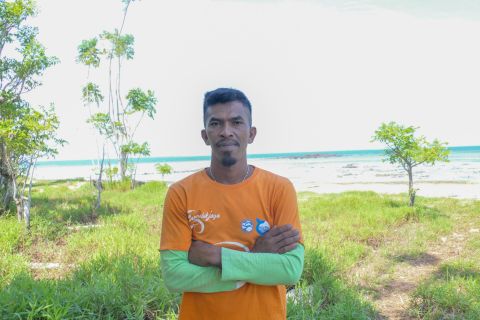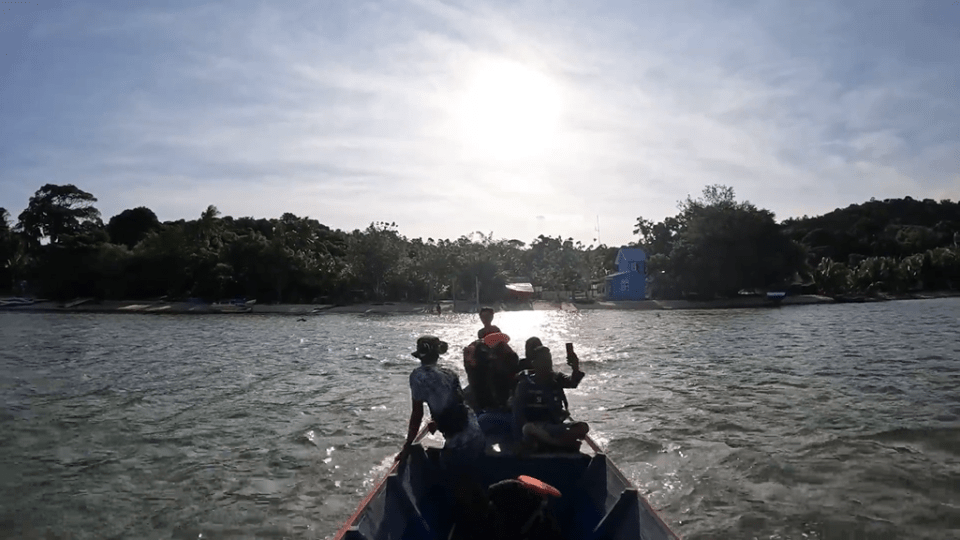
My name is Hartono. I was born on Cempedak Island in 1983 and have been living on this island ever since. Cempedak Island is located 53.9 km from the small town of Kendawangan, which is situated in the southern part of West Kalimantan. Using a small motorboat, Cempedak Island can be reached within 50 minutes to an hour.
I work as a fisherman, and currently, I am actively serving as the head of the neighborhood and the head of the Cempedak Jaya Ketapang Tourism Group (Pokdarwis), which was established in 2020. Pokdarwis is a Tourism Awareness Group, a community dedicated to enhancing tourism in their region. On Cempedak Island, this community comprises fishermen who also work as tour guides for tourists. The inception of this community was originally facilitated by the WeBe Foundation, a partner of YIARI, with a focus on monitoring dugongs and the habitats of protected and endangered marine animals, which are still commonly found in the waters around Cempedak Island and its vicinity. Since then, Pokdarwis Cempedak Jaya has been involved in ecotourism development activities that promote tourism supporting the preservation of marine animal habitats and their ecosystems. These activities include monitoring patrols and educating tourists, raising awareness about participating in the protection of marine habitats and animals.
I have three children, and currently, the most significant challenge we face on this island is educating the younger generation to be more environmentally conscious. The level of education here is quite limited. After completing elementary school, we have to send our children to schools on the island of Borneo since there are no junior high schools or higher-level schools here. In the absence of such schools, we must educate the children here to be responsible for protecting the environment, which is experiencing a decline in quality. The condition of the sand on Cempedak Island and the surrounding islands has deteriorated compared to when I was a child. Similarly, the presence of seagrasses, which serve as ecosystems for dugongs and marine animals, has significantly decreased. Another challenge is the issue of plastic waste, for which we have not yet found a solution on how to reduce and manage it effectively on the islands and in the surrounding seas.

In my opinion, the most significant challenge we face is changing the habits of the people on our island to minimize the use of plastic.
At Pokdarwis, we strive to empower this community to contribute to the local economy. Currently, our tourism activities primarily involve picking up tourists from Kalimantan Island in Kendawangan, taking them on tours around the islands while providing information about the natural richness of Cempedak Island and its surroundings, and preparing seafood dishes for them. Our most popular seafood catches include lobsters, fish, and crabs.
In addition to tourism activities, we conduct sea patrols every two days, with each boat carrying three people. In total, our Pokdarwis group comprises 23 members, 18 of whom actively participate in these patrols. During our patrols, we document the appearances of dugongs, dolphins, or whales, as well as any instances of these rare marine animals being found deceased. We also encourage the public to protect the existence of dugongs and change the old habits of consuming them. Before our establishment, there were frequent dugong deaths, with 3-4 deaths occurring at the beginning and end of each year. However, in 2019-2020, only one dugong death was recorded, and from 2020 to the present, there have been no recorded deaths.
We are grateful that our efforts to protect nature have been recognized through several awards. I received the 1st Runner Up Local Heroes award at the 2021 International Ocean Award. Additionally, Pokdarwis Cempedak Jaya was selected as one of the 23 finalists for the Ocean Award 2021. Hopefully, with these awards, we will be further motivated to protect the environment on our island, ensuring that future generations can continue to witness the presence of marine animals during months like August and April, when the seasons change and the waters are calm. During these times, we often observe dolphins, hunting whales, and porpoises crossing the waters. We hope that our children and grandchildren can continue to experience this natural beauty.

